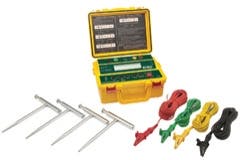Standards introduce new products, procedures for grounding, bonding
April, 2012 Issue of Cabling Installation & Maintenance Magazine
Two sets of specifications recently made available ramp up the amount of information to know about telecommunications grounding and bonding.
By Patrick McLaughlin
In the summer of 2011, professionals who design, install and manage telecommunications cabling systems gained access to two new sets of specifications detailing the equipment and procedures associated with earthing (grounding) and bonding those cabling systems.
In August 2011, the National Electrical Contractors Association (NECA; www.necanet.org) and BICSI (www.bicsi.org) announced the availability of the specification they jointly developed, NECA/BICSI-607-2011 Standard for Telecommunications Bonding and Grounding Planning and Installation Methods for Commercial Buildings. Around the same time, the latest grounding-and-bonding standard from the Telecommunications Industry Association (TIA; www.tiaonline.org), ANSI/TIA-607-B Generic Telecommunications Bonding and Grounding (Earthing) for Customer Premises, became available for purchase.
At the time NECA announced the availability of the NECA/BICSI standard, the organization said it “will help contractors and installers enhance the planning, specification and layout of an effective telecommunications bonding and grounding system. The standard also specifies installation requirements for components of the telecommunications bonding and grounding systems.”
Meanwhile, work on the TIA-607-B standard had been completed earlier in 2011, and the document completed the publication process later in the year. Shortly after the TIA TR-42 Committee approved 607-B, the committee’s chairman Bob Jensen explained to Cabling Installation & Maintenance that the “B” revision of the standard expands the scope of equipment and spaces within a telecommunications system that are addressed. 607-B covers grounding systems “all the way from the entrance facility to equipment racks,” Jensen explained. “The previous 607 standard did not include anything from the TR [telecommunications room] to the racks. It now includes environments like computer rooms and data centers.”
The posture among the creators of these specifications is that they are complementary in nature, and system designers and installers would be best served to understand both rather than choose one or the other. BICSI says the NECA/BICSI spec “aligns with related standards,” but adds that it includes information that others do not. In addition to the TIA-607-B specification, BICSI references the National Electrical Code as a document with which NECA/BICSI-607 aligns.
In their book entitled Cabling: The Complete Guide to Copper and Fiber-Optic Networking, authors Andrew Oliviero and Bill Woodward include several mentions of ANSI/TIA-607-B; they also emphasize the importance of being familiar with several grounding/bonding specifications. Of ANSI/TIA-607-B, the authors say, “This document should be used in concert with Article 250 and Article 800 of the NEC. ANSI/TIA-607-B does not cover building grounding; it only covers the grounding of telecommunications systems.”
Their section on 607-B later states, “Grounding is one of the most commonly overlooked components during the installation of a structured cabling system … Time after time we have heard stories of improperly grounded (or ungrounded) telecommunications cabling systems that have generated mild electrical or throw-you-off-your-feet shocks; they have even resulted in some deaths.”
The TIA-607-B specification includes several new elements, as Jensen pointed out. For example, a rack grounding busbar (RGB) can be mounted either horizontally at the top of a rack, or vertically onto a rack. Pieces of equipment within the rack are bonded to the RGB via rack bonding conductors.
The telecommunications equipment bonding conductor (TEBC) is a new component in TIA-607-B; it runs from the telecommunications grounding busbar (TGB) or the telecommunications main grounding busbar (TMGB), to which each rack or cabinet is bonded. The RGB in each rack or cabinet is bonded to the TEBC via an irreversible crimp connection. A telecommunications space is not limited to one TEBC.
The standard also specifies a mesh bonding network, or mesh-BN. Typically the mesh-BN is used in computer rooms and large TRs. It is similar to the TEBC, but is created in mesh form. The attachment of a rack bonding conductor to the mesh-BN also is accomplished with an irreversible crimp connection.
The standard also calls for a two-point ground test that follows a visual inspection of the installed earthing/bonding system. ANSI/TIA-607-B specifies a maximum value for the resistance between any point in the earthing/bonding system and a building’s electrical grounding-electrode system. Technicians use an earth-ground resistance tester to conduct the standard-specified tests.
Oliviero and Woodward further advise in their book, “Grounding is not to be undertaken by the do-it-yourselfer or an occasional cable installer. A professional electrician must be involved. Further, electricians must be involved when a telecommunications busbar is tied into the main building grounding system.” The duo also provide a specific warning: “Grounding to a water pipe may not provide you with sufficient grounding, as many water systems now tie into PVC-based (plastic) pipes. It may also violate NEC and local-code requirements.”
The earthing (grounding) and bonding of a telecommunications system always generates lively discourse in the many formats in which it is discussed. With the National Electrical Code, a standard developed jointly by NECA and BICSI, and a “B” revision of the TIA’s 607 standard now addressing the topic, system designers, installers and managers have more opportunities than ever before to cite documentation of proper components, techniques and results.
Patrick McLaughlin is our chief editor.
Past CIM Articles


